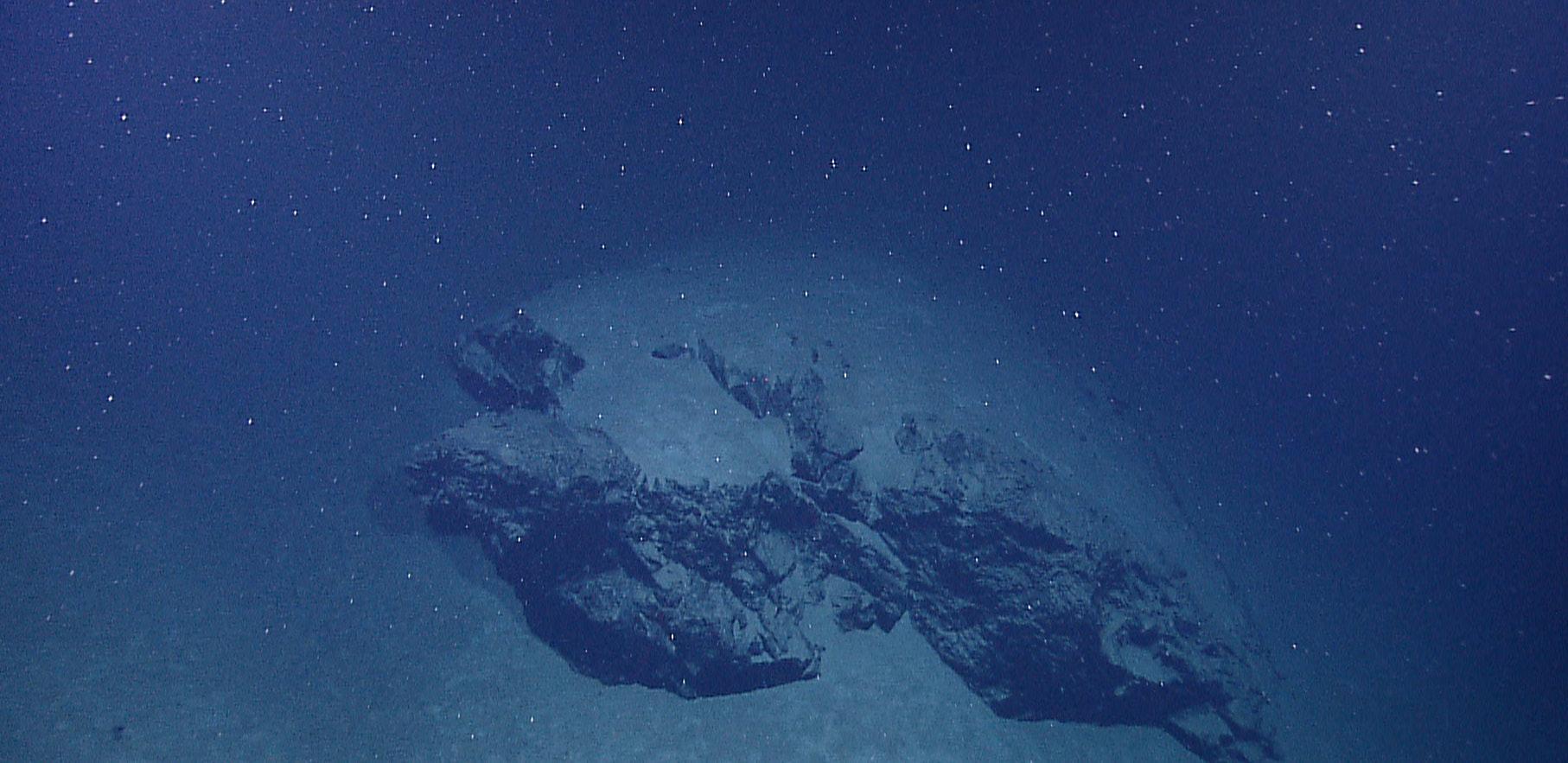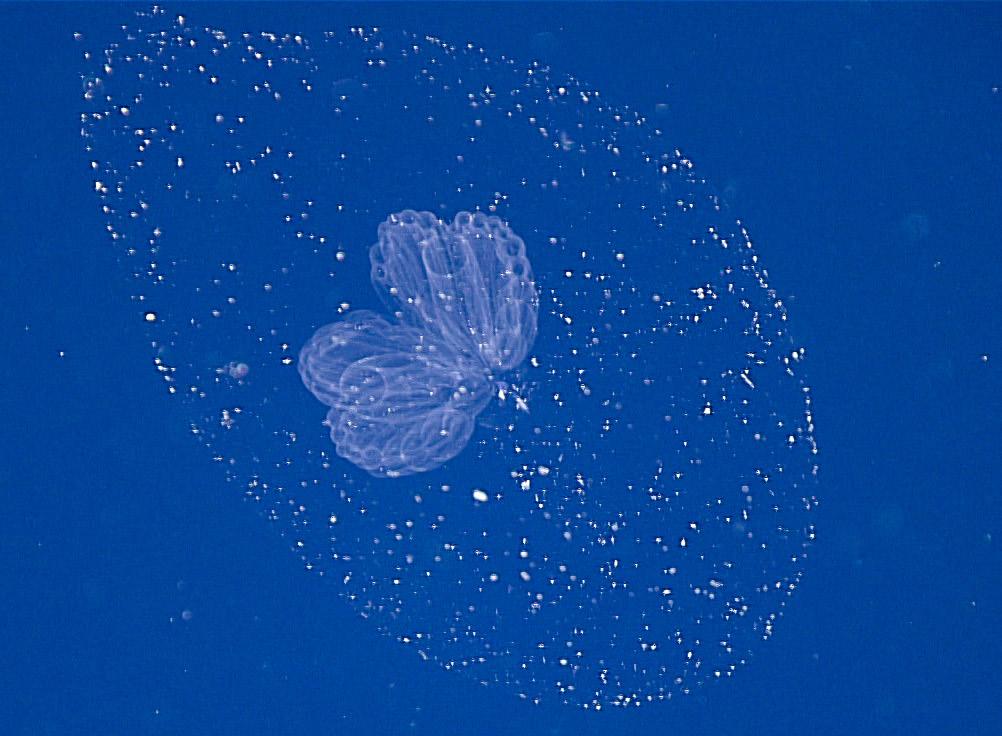
9 minute read
Marine Snow: The Largest Snowfall on Earth Lilian Eloyan
MARINE SNOW: THE LARGEST SNOWFALL ON EARTH
BY LILIAN ELOYAN
Advertisement
Imagine if you could dive straight into the ocean and just keep swimming down, unrestrained by physical limitations. At first, you’d be in a world of wonder, surrounded by a plethora of unique shapes and colors: vibrant fish popping out from every corner of coral, anemones and seaweeds drifting in the current. The water would be warm, saturated by the sun’s rays, and for this reason the pelagic zone of the ocean is bursting with life. Once you pass two hundred meters underwater, however, things start to look a little different. Entering the mesopelagic zone, also known as the twilight zone, the sunlight begins to fade and all of a sudden you hit a wall of cold water, the permanent thermocline, where water temperature rapidly drops below 43 degrees Fahrenheit. 1 Somewhere between 200 and 1,000 meters you’ll enter the oxygen minimum zone, where oxygen saturation in the water column is at its lowest. The reduced amount of light means fewer photosynthetic organisms like plants and cyanobacteria. No photosynthesis means no oxygen, and no oxygen means no life. A ghost world.
The farther down you swim, the further away the concepts like night and day and seasons begin to drift. But then, to your surprise, you see—with eyes equipped with night vision, of course—a burst of life, movement in the darkness. Passing a thousand meters, you reach the bathyal layer of the ocean, or the midnight zone; life begins to thrive again despite the absence of even a single ray of sunlight. Even deeper, at 4,000 meters, you’ll reach the abyss where life is still abundant despite the seemingly uninhabitable conditions. The increase in life here is due to thermohaline circulation, or the ocean conveyor belt, a system of deep-ocean water circulation through which oxygen-rich water from the surface sinks down to the ocean floor, supplying animals with life-sustaining O 2 . 1 And lastly, you’ll enter the hadal layer of the ocean or the trenches. True to its name, it is the underworld where strange is the norm. LIFE WITHOUT SUNLIGHT
In the deep sea, biomass, or the total combined mass of individuals per species, is relatively low compared to that of the surface regions, but the biodiversity is unmatched in the ocean. 1 Creatures of the deep have evolved over billions of years to perfectly suit life over a thousand meters beneath the ocean’s surface. Since photosynthesis is impossible here, some fascinating

Figure 1: Black smoker hydrothermal vents located in New Zealand’s southern caldera secreting hot water full of minerals such as iron sulfide, which chemosynthetic bacteria can use to extract energy.
creatures use another method of extracting energy from the world around them: chemosynthesis. Before cyanobacteria came nonphotosynthetic bacteria. 2 In the early days of the Earth, primitive lifeforms used the concoction of gases in the Earth’s atmosphere to extract energy from chemical reactions (Fig. 1). 2 Just as baking soda and vinegar create energy for a volcano science project, chemical energy was used by some of the first-ever life forms on Earth. A few billion years ago, one bacterium’s mutation allowed it a much more efficient means of deriving energy: from the sun. 2 The rest is history. Today, sulfur chemoautotrophic bacteria still extract energy from the hydrogen sulfide pockets found in the Earth’s crust that erupt through hydrothermal vents at the seafloor. 3 These bacteria form the basis of unique food webs where species richness is low, but biomass is teeming. They provide food for species such as hydrothermal vent shrimp and tubeworms that are endemic to these nutrient-rich areas. 3
MARINE SNOW
However, such evolutionary adaptations as those apparent in chemosynthetic bacteria are few and far between as most life in the deep depends solely on what drifts down from above. Marine snowfall occurs in the ocean year-round, but unlike snow on land, it is not composed of soft, beautiful ice crystals. Rather, it is composed of biological debris, mainly the remains of plankton and fecal pellets that clump together to form particulate organic matter (POM) as they drift down. 4 This phenomenon may not sound important to us, but for creatures in the deep, it is indispensable. At the surface of the ocean, photosynthetic organisms form the basis of the food web, but in the deep sea, most animals rely on marine snow for food. 4 Many animals like the giant larvacean have adapted unique strategies for catching this marine snow to eat. 5 Contrary to its name, the giant larvacean, a tadpole-like filter feeder, is only about four inches wide, yet it casts a mucus net that spans over a meter, collecting marine snow as it falls (Fig. 2). 5 Once the net gets too heavy to bear, the larvacean discards it and the net then acts as food for other deep-sea dwellers like the vampire squid. 5
POM is part of the biogeochemical process known as the carbon cycle (Fig. 3). The plankton or microscopic crustaceans that make up most of the POM contain carbon in their bodies due to the ocean’s absorption of carbon dioxide from the atmosphere. 6 Once these organisms are consumed by predators or begin to decompose, the carbon is released back into the atmosphere as CO 2 . 6 Any unused or unconsumed particles of POM, however, drift to the seafloor, sometimes taking weeks to reach the bottom. The POM piles up on the seafloor and forms a thick, carbon-dense topsoil layer of sludge. 6 This sludge hardens into sediment deposits of limestone where carbon is locked away through a process called mineral carbonation, eventually covering over one billion square miles of the seafloor and becoming several hundred meters thick. 7 Thus, marine snow is a natural form of carbon sequestration. By Figure 2: A giant sea larvacean (Bathochordaeus charon) and the mucus net it constructed to collect the falling marine snow, its main food source.

effectively dragging carbon down to the ocean floor, it can be tucked away in rock for millions of years, only returning to the atmosphere through periodic volcanic eruptions. 7
Over time, marine snow stores more and more carbon in the oceans’ depths. According to a 2019 modeling study, in the Cretaceous period about 80 million years ago, roughly one million tons of carbon in the form of carbonate were stored each year in deep-sea sediments. 8 These carbon stores were responsible for cooling the Earth’s climate enough to sustain life for a number of animals, most notably dinosaurs. 8 Today, scientists estimate that over 200 million tons are deposited and stored annually. 8 The underwater sediments formed by marine snow are the world’s largest means of carbon storage, and if it weren’t for this natural cycle, the amount of carbon dioxide in the atmosphere would make Earth too warm for habitation due to the greenhouse effect. 9 Carbon dioxide in the atmosphere acts as a greenhouse gas, absorbing and trapping heat, making the Earth’s climate warmer. 9 Today, by burning fossil fuels and cutting down carbon dioxideabsorbing forests, we reverse the natural cycles that have helped make Earth a comfortable home for all life forms.The ocean soaks up the excess carbon dioxide produced by humans, effectively absorbing 90% of the planet’s excess heat. 10 With more carbon dioxide in the atmosphere, however, oceanic carbon sequestration is disrupted as increased oceanic CO 2 levels raise the water’s acidity, harming the plankton community and decreasing the amount of falling marine snow. 10,11 Although we may feel utterly disconnected from what lies beneath the waves, what occurs up to 11,000 meters deep in the ocean affects us in more ways than most of us realize.
As you start to make your ascent, swimming past angler fish and other various bioluminescent beasts, avoiding some sharks, then finally back to warm, sunny, waters full of clownfish and turtles, you’ll eventually be met with a refreshing burst of cool air once you break through the surface of the water, partly thanks to marine snow.

Figure 3: The ocean’s biological carbon pump is a key piece of the Earth’s carbon cycle as carbon-rich particulate organic matter sinks to the seafloor.
Acknowledgments: I would like to acknowledge professor of biology at Glendale Community College, Dr. Maria Kretzmann, for her contribution to the writing process with valuable feedback regarding marine biology and evolution.
REFERENCES
Gago, F. J. (2018). Marine Biology Course Reader. Division of Biology, 23–26, 251, 267-270. Glendale Community College. Martin, W., Baross, J., Kelley, D., & Russell, M. J. (2008). Hydrothermal vents and the origin of life. Nature Reviews Microbiology, 6(11), 805-14. https://doi.org/10.1038/ nrmicro1991 Shank, T. M. (1998). Temporal and spatial development of communities at nascent deep-sea hydrothermal vents and evolutionary relationships of hydrothermal-vent caridean shrimp (bresiliidae) (Order No. 9900698). Available from ProQuest Dissertations & Theses A&I; ProQuest Dissertations & Theses Global. (304450586). Retrieved from https://search-proquest-com.libproxy.berkeley.edu/ docview/304450586?accountid=14496 Alldredge, A. L., & Silver, M. W. (1988). Characteristics, dynamics and significance of marine snow. Progress in Oceanography, 20(1), 41–82. https://doi.org/10.1016/0079- 6611(88)90053-5 6.
7.
8.
9.
10.
11. 1. 2. 3. 4. MBARI researchers discover what vampire squids eat. (2012). Ocean News & Technology, 18(10), 24-25. Retrieved from https://search-proquest-com.libproxy.berkeley.edu/ docview/1214386416?accountid=14496 Turner, J. T. (2015). Zooplankton fecal pellets, marine snow, phytodetritus and the ocean’s biological pump. Progress in Oceanography, 130, 205–248. https://doi.org/10.1016/j. Pocean.2014.08.005 Riebeek, H. (2011, June 16). The Carbon Cycle. Nasa.Gov; NASA Earth Observatory. https://earthobservatory.nasa.gov/ features/CarbonCycle Dutkiewicz, A., Müller, R. D., Cannon, J., Vaughan, S., & Zahirovic, S. (2019). Sequestration and subduction of deepsea carbonate in the global ocean since the Early Cretaceous. Geology, 47(1), 91–94. https://doi.org/10.1130/G45424.1 Barral, A., Gomez, B., Fourel, F., Daviero-Gomez, V., & Lécuyer, C. (2017). CO 2 and temperature decoupling at the million-year scale during the Cretaceous Greenhouse. Scientific Reports, 7(1), 1–7. https://doi.org/10.1038/s41598- 017-08234-0 Basu, S., & Mackey, K. R. M. (2018). Phytoplankton as key mediators of the biological carbon pump: Their responses to a changing climate. Sustainability, 10(3), Article 869. https:// doi.org/10.3390/su10030869 Cartapanis, O., Galbraith, E. D., Bianchi, D., & Jaccard, S. L. (2018). Carbon burial in deep-sea sediment and implications for oceanic inventories of carbon and alkalinity over the last glacial cycle. Climate of the Past, 14(11), 1819–1850. https://
doi.org/10.5194/cp-14-1819-2018 IMAGE REFERENCES
Banner: National Oceanic and Atmospheric Administration Ocean Explorer Program, MCR Expedition. (2011, August 8). Marine Snow [jpg image]. https://oceanexplorer.noaa. gov/okeanos/explorations/ex1104/logs/aug8/media/aug8- wp-mcr06.html Figure 1: National Oceanic and Atmospheric Administration. (2008, April 7). Brothers blacksmoker hires [jpg image]. https://no.wikipedia.org/wiki/Fil:Brothers_blacksmoker_ hires.jpg Figure 2: NOAA Office of Ocean Exploration and Research. (2017, December 14). Larvacean House [jpg image]. https:// oceanexplorer.noaa.gov/okeanos/explorations/ex1711/ dailyupdates/media/dec14-2.html Figure 3: Ocean & Climate Platform. (2020). [Diagram of a biological carbon pump, jpg image]. https://ocean-climate. org/?page_id=3896&lang=en










